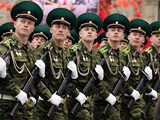Moscow's Security Plans Face Reality Check
By Sergei Blagov for ISN
Russia and China have pledged to jointly combat extremists, separatists and counter other security threats in the region, a move that is the culmination of "Peace Mission 2009," a joint anti-terrorism military exercise held 22-26 July in Russia's Far East city of Khabarovsk and on China's Taonan training base, which borders the Russian region.
About 3,000 army and air force personnel from both sides took part in the exercise. The start of the drill, which acknowledged growing security ties between the two powers, was jointly announced by Chen Bingde, general staff chief of China's People's Liberation Army, and his Russian counterpart Nikolai Makarov, with the latter stating that Russia and China should develop military cooperation in the wake of North Korean missile tests that prompted intensified military preparations in Japan and South Korea. He also cited "complicated" situations in Central Asia, Afghanistan and Pakistan as rationales for bilateral military ties.
Both Russia and China have argued that the joint exercises, as well as similar drills in the past, were not intended to target any third country. However, the US’ growing engagement with Central Asia, as well as Japan and South Korea, may have sparked suspicions in Moscow and Beijing that the US is pursuing an encirclement strategy.
In the immediate aftermath of the Sino-Russian military exercises, Moscow moved to strengthen the Collective Security Treaty Organization (CSTO) and its Rapid Reaction Force (KSOR). At a summit meeting in the Kyrgyz capital Bishkek on 1 August, the leaders of the Russian-led CSTO, which includes Armenia, Belarus, Kazakhstan, Kyrgyzstan, Tajikistan and Uzbekistan, agreed to hold a two-month-long KSOR drill starting in August that would involve some 6,000 personnel.
On 14 June, CSTO leaders signed an agreement to form KSOR, although Belarus and Uzbekistan abstained. The CSTO currently has a collective force, KSBR, which includes 10 battalions (five from Russia, two from Kazakhstan and Tajikistan each and one from Kyrgyzstan). KSOR is planned to be KSBR’s larger, stronger replacement.
Belarus authoritarian leader Alexander Lukashenko opted to boycott the June summit meeting in Moscow, during which his country was scheduled to assume the CSTO rotating presidency. The boycott, which was prompted by economic disagreements with Moscow, forced Russia to assume temporary presidency. Following the August summit meeting in Kyrgyzstan, Russia continued its ‘technical presidency’ of the CSTO. Belarus’ demarche came as an unprecedented rift in the history of post-Soviet alliance-making.
Russian officials insisted their efforts to bolster security by setting up a rapid response task force remained on track. In Bishkek, Russian President Dmitry Medvedev and Kyrgyz President Kurmanbek Bakiyev signed an agreement to deploy an extra Russian battalion in southern Kyrgyzstan and create a joint training center. Russia already has one military base in the country.
The display of combined Russian and Chinese military might was apparently designed to send a signal to the region that both Moscow and Beijing would remain wary of western inroads into the strategically important Central Eurasia. However, Russian security plans are actually undergoing a reality check as the Russia-led CSTO faces an uncertain future.
About 3,000 army and air force personnel from both sides took part in the exercise. The start of the drill, which acknowledged growing security ties between the two powers, was jointly announced by Chen Bingde, general staff chief of China's People's Liberation Army, and his Russian counterpart Nikolai Makarov, with the latter stating that Russia and China should develop military cooperation in the wake of North Korean missile tests that prompted intensified military preparations in Japan and South Korea. He also cited "complicated" situations in Central Asia, Afghanistan and Pakistan as rationales for bilateral military ties.
Both Russia and China have argued that the joint exercises, as well as similar drills in the past, were not intended to target any third country. However, the US’ growing engagement with Central Asia, as well as Japan and South Korea, may have sparked suspicions in Moscow and Beijing that the US is pursuing an encirclement strategy.
In the immediate aftermath of the Sino-Russian military exercises, Moscow moved to strengthen the Collective Security Treaty Organization (CSTO) and its Rapid Reaction Force (KSOR). At a summit meeting in the Kyrgyz capital Bishkek on 1 August, the leaders of the Russian-led CSTO, which includes Armenia, Belarus, Kazakhstan, Kyrgyzstan, Tajikistan and Uzbekistan, agreed to hold a two-month-long KSOR drill starting in August that would involve some 6,000 personnel.
On 14 June, CSTO leaders signed an agreement to form KSOR, although Belarus and Uzbekistan abstained. The CSTO currently has a collective force, KSBR, which includes 10 battalions (five from Russia, two from Kazakhstan and Tajikistan each and one from Kyrgyzstan). KSOR is planned to be KSBR’s larger, stronger replacement.
Belarus authoritarian leader Alexander Lukashenko opted to boycott the June summit meeting in Moscow, during which his country was scheduled to assume the CSTO rotating presidency. The boycott, which was prompted by economic disagreements with Moscow, forced Russia to assume temporary presidency. Following the August summit meeting in Kyrgyzstan, Russia continued its ‘technical presidency’ of the CSTO. Belarus’ demarche came as an unprecedented rift in the history of post-Soviet alliance-making.
Russian officials insisted their efforts to bolster security by setting up a rapid response task force remained on track. In Bishkek, Russian President Dmitry Medvedev and Kyrgyz President Kurmanbek Bakiyev signed an agreement to deploy an extra Russian battalion in southern Kyrgyzstan and create a joint training center. Russia already has one military base in the country.
The display of combined Russian and Chinese military might was apparently designed to send a signal to the region that both Moscow and Beijing would remain wary of western inroads into the strategically important Central Eurasia. However, Russian security plans are actually undergoing a reality check as the Russia-led CSTO faces an uncertain future.

